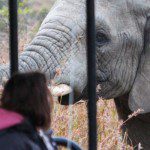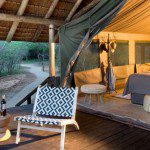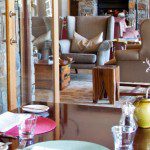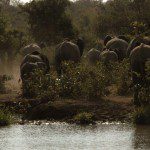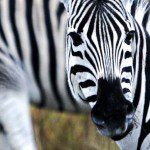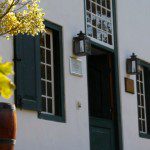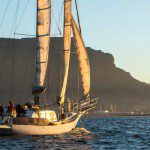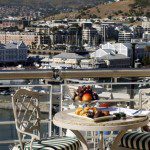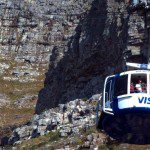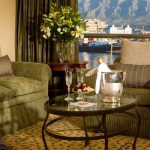Blending wellness with wildlife where wildebeest roam freely, SouthAfrica offers much to soothe the soul while titillating the senses. Fiona Harper succumbed to South Africa’s charms.
[vc_row][vc_column width=”1/4″][vc_separator color=”black” border_width=”10″][vc_custom_heading text=”South Africa”][vc_separator color=”black” border_width=”2″][vc_widget_sidebar sidebar_id=”sidebar-page”][/vc_column][vc_column width=”3/4″][vc_column_text]
wines, wildebeest & wellness
Blending wellness with wildlife where wildebeest roam freely, South
Africa offers much to soothe the soul while titillating the senses. Fiona
Harper succumbed to South Africa’s charms.
- Open topped jeeps are the perfect way to view wildlife up close and personal in safety
- Tanda Tula camp, a luxury glamping in Timbavati Game Reserve
- At Karkloof Safari Spa guests are invited to treat the lodge like their own home
- Elephants at Tanda Tula Watering Hole
- Zebras pose as though scripted for our cameras
Pampered and pummelled into a blissful state of semiconsciousness, my limbs feel detached, lifeless. My legs have the strength of jelly causing me to wonder if I’ll have the strength to walk back to my villa. On the grassy plain beyond the glass walls of the treatment room a dazzle of frisky zebras kick up their heels. Metres away from where I lay a doe-eyed nyala, a sort of Bambi lookalike, grazes on the bushes. It’s such a surprise, as my mind registers where I am after dozing off during a hot oil head massage that I gasp with delight. Trei, my Thai masseuse has seen it all before and smiles indulgently. As she ushers me back to the lounge, padding softly across the boardwalk she points out warthogs nearby while wildebeest graze further afield. It’s the first of numerous wild animal encounters.
Unlimited Redefined
at Karkloof Safari Spa
I’ve checked into Karkloof Safari Spa for an indulgent Signature Rock Fig Experience in the Karkloof Valley outside Pietermaritzburg. It really should be named the Unlimited Experience. Everything is at my disposal like unlimited treatments and use of Spa facilities, unlimited meals, snacks and beverages (the only exception in the walk-in cellar being French champagne) with unlimited game drives with a personal guide. Naturally there’s a personal Chef on hand to customise menus to suit needs and desires. I’m welcomed to treat Karkloof like my home, admittedly one with a staff of 60 that is kitted out with an astounding array of artefacts. Kudu antlers are crafted into candle holders, the bovine rug beneath my feet is a rare Zulu status symbol. An adults only plush retreat, Karkloof successfully combines wellness and wilderness for the well-heeled. Staff are skilled in impeccable, intuitive service, discreetly absent while we chat over sundowners and aperitifs on the deck, silently appearing the moment my glass shows a hint of being the ‘half empty’ kind.
Between spa treatments we explore the 3,5000 hectare reserve in an open-topped safari jeep. Our guide packs a picnic hamper for refreshments along the way. White and black rhino, wildebeest, buffalo, zebra, warthog and monkey are plentiful. So too are nyalas and springbok, their skinny legs, pert bottoms and skittish antics an endless source of amusement.
Game drives and safari lodges are to South Africa like yachting and overwater bungalows are to Tahiti. The first decisions you’ll need to make are which game reserve to explore, then where to bed down after twice daily safari drives that may occupy anything up to four hours if trackers get a sniff of wildlife worth following. The Big Five are on everyone’s list: lion, leopard, elephant, rhino and buffalo.
Tracking down the Big 5
at Nambiti Private Game Reserve
A Big Five Game Reserve, Nambiti is midway between coastal Durban and inland Johannesburg. The Drakensberg Mountains dominate the horizon with their basaltic buttress rising above the plains.
It takes about 3 hours to drive to Nambiti from Johannesburg but you could also charter an aircraft and land at the parks airstrip or helicopter landing pads. KwaZulu Natal province is renowned for its extraordinarily beautiful landscapes and Nambiti doesn’t disappoint.
A former cattle station 15 years ago, the land was declared a 21,000 acre nature reserve and revegetated with native plants and wildlife including the Big Five. They’re the most coveted animals to spot during twice daily jaunts but equally sought after are the giraffe, zebra and any number of deer species. The lesser known but no less unique, Small Five, are also in residence at Nambiti: ant lion, leopard tortoise, elephant shrew, rhinoceros beetle and buffalo weaver (a bird). You’ll need to keep your eyes peeled to spot them though!
Lions Valley Lodge is one of nine lodges (plus one tented camp) discreetly located around the park. Freestanding thatched roof huts have commanding views particularly from the suitably named Romance Suite where duel bathtubs overlook a raised deck, down the valley to the ridge beyond. Don’t be surprised to spot giraffes, their necks elegantly extended skywards, grazing beyond the glass walled shower. A horizon swimming pool overlooks a waterhole favoured by giraffes and zebras. nambiti.com
Timbavati
in the famous Kruger National Park
Sharing an unfenced border with world famous Kruger NationalPark, Timbavati forms part of a significant wildlife movement corridor. A cooperative of sorts, the park was established by conservation minded landowners to address degradation of former wilderness and to protect remaining unspoilt tracts of land. The elusive White Lions of Timbavati are the most famous residents, their white coats attributed to lions holding spiritual powers.
Stretching across over 53,000 hectares of bushveld, twelve lodges offer a variety of accommodation from tented camps through to five star luxuries with an African twist.
Camping is rarely as dignified as the style on offer at Tanda Tula Safari Camp. For a start, vast adobe-walled ensuite bathrooms are attached to each tent, complete with a claw foot bath and an open roofed shower. Canvas walls roll up on three sides affording views over the riverbed from a wrought iron king-sized bed piled with fluffy doonas and cushions. With safaris setting out each morning before dawn, fresh toast and steaming tea are delivered pre-dawn by the same trackers who take us on safari shortly afterwards. It’s luxurious glamping at its best. tandatula.com
Across an open savannah plain Kings Camp is more King than camp. In thatched roof bungalows, zebra and antelope skins adorn polished concrete floors, crisp white netting is draped over a hardwood carved four poster bed. Returning from dinner served on fine china, I’m delighted to find that as part of the turn down service candles have been lit, the bath is filled with hot water while aromatic rose petals float prettily.
A trifle formal in a Colonial fashion, while pounding the treadmill in the glass walled gym I watch curiously cheeky monkeys dashing around the swimming pool deck.
- Cellar doors are plentiful throughout the Franschhoek Valley
- Linger for lunch at one of Franschhoek vineyards to savour sunshine-dappled views of mountains and valley
Game drives and safari lodges are to South Africa like yachting and overwater bungalows are to Tahiti.
South Africa’s finest wines
at Franschhoek
A couple of hours east of Capetown on a valley floor surrounded by mountainous nature reserve, Franschhoek is the definitive food and wine heartland of South Africa. Here it’s all about long leisurely lunches, cellar door sales and soaking up a sun-drenched Mediterranean-like climate with an African twist. If you’ve a penchant for some two-wheeled exercise, the region is well known for being cyclist-friendly. There are some easy off-road trails along with plenty of leisurely, traffic-free back roads for ambling between vineyards. Hire a bike and safety gear from Franschhoek Cycles, run by former World Champion mountain biker.
Le Franschhoek Hotel & Spa is located ten minutes from the pretty village of Franschhoek with its ravishing Cape Dutch architecture. The hotel sits on the site of one of Franschhoek’s former opulent country retreats. Multi-paned windows frame the view of meticulously maintained gardens. Violet-hued agapanthas dominate lush floral displays shaded by deciduous trees ablaze in seasonal glory. It’s the sort of place that entices one into the outdoors to poke along meandering paths and smell the roses so to speak. But not for too long as lunch beckons on the food and wine trail and that’s the real reason to visit this region. With almost 50 vineyards across the valley, we spend a leisurely few hours on a veranda bathed in sunshine at Solms Delta enjoying an exquisite lunch. Temptations such as biltong and blue cheese pate followed by lamb loin stuffed with wild herbs and garlic, rosemary braised onions and fennel, baby potatoes are drizzled with a Cape Jazz Shiraz jus. Accompanied by lashings of crisp rose blend seasoned in oak, it’s easy to see the attraction of the Cape Wine lands. Rickety Bridge Wine Estate is another one worthy of lingering over a fine alfresco lunch, attended to by friendly staff who know how to match a remarkable menu with exceptional wines. A perfect Franschhoek day easily revolves around a morning bike ride or walk, rejuvenating lunch topped off with splendid South African wine, shopping for trinkets in bespoke boutiques in the village, an indulgent spa treatment back at the hotel before dinner at yet another exquisite restaurant.
It’s quite a contrast to conditions Nelson Mandela experienced nearby during his own time in Franschhoek Valley. His long walk to freedom culminated in the 1990 release from Drakenstein Prison, since commemorated in a large than life bronze statue outside the prison gates.
Table Mountain’s splendour
from every vista
Mandela’s commanding presence is evident in Cape Town too, though it’s hard to ignore the commanding presence of Table Mountain. Take a trip to the summit via a revolving cable car where there’s a café, walking trails and mesmerising views of Cape Town below with its sweeping bays and intimate coves lined by strips of white sand. It’s usually best to go in the morning before the wind has a chance to build momentum. The flat topped summit is often shrouded in mist, creating a white ‘tablecloth’ that drapes down a near vertical bluff.
Cape Town’s weather can be challenging: golden sunshine one day, screaming gales the next. But what the heck, pack clothes for all seasons and get out and explore: Cape Town is physically beautiful regardless of her mood.
Blessed with blue sky and sunshine we take a scenic helicopter flight for a bird’s eye view of Table Mountain before flying over the Cape of Good Hope. There’s nothing south of here until Antarctica but the raw, wild Southern Ocean with the cape protruding into the Roaring Forty latitudes. Cape Town has always been a sailor’s town since scurvy-riddled Spanish sailors landed at the Cape of Good Hope in the 1500’s. Changing forever the equilibrium of resident indigenous nomads, the city’s population today is a civilised multi-racial melting pot drawn from countries near and far. The V & A Waterfront precinct (as in Victoria & Albert) is the throbbing heart of the waterside.
The Table Bay Hotel sits front and centre in the thick of all the action. Request a mountain view room to watch her changing moods from the comfort of your plush king bed. It would be no hardship to remain ensconced within Table Bay’s fine walls for a week or more and not grow bored. Nor hungry. Breakfast in The Atlantic dining room claims to be the best in Cape Town. We’re not arguing. It is simply divine. From the grand piano with tuxedo-clad pianist tinkling in the corner, to an elegant spread to accommodate travellers from across the globe to simple touches like fresh squeezed juice, this is breakfast with real panache. Allow a couple of hours and savour the pure joy of lingering over a leisurely multi-course breakfast.
Skip lunch in order to make room for High Tea in The Lounge mid-afternoon where delightful delicacies are delicately devoured. Walls of glass overlook docked boats in the harbour foreground while that ‘look at me’ mountain dominates the rest of the view. If you can be enticed beyond this heavenly hotel there are plenty of diversions within a short walk. Dipping its hat to slave trading with tendrils reaching into Madagascar, Malaya, India, Madagascar and West African nations blended with European influences, Cape Cuisine is a confluence of cultures. Alongside V & A Waterfront canals a sustainable organic food market powered by aquaponics and solar energy is styled on an African souk offering alfresco dining at its eco-friendly best. Nearby, V&A Food Market on the Wharf offers a fascinating insight into what tickles local tastebuds in almost 50 cafes, take away joints and market stalls. Bluestone Ferryman’s Tavern does a mean steak and chips washed down with local handcrafted brews in their cobblestoned courtyard. Pop upstairs to the Peroni Deck at Alba’s Lounge for cocktails at sundown to see the harbour transform into a sea of twinkling evening lights. Hildebrande Ristorante (with a chocolatier history harking back to the late 1800’s) dishes up a beguiling menu favouring Italy and seafood dishes – try their specialty springbok shank.
There’s no end of opportunities at V&A Waterfront to pick up trinkets and the like to take home. Africa Trading Port, housed in an historic Port Captains Building, has three floors crammed with artefacts, antiquities and artworks. From giraffe hide wall hangings to a Mandela sculpture cleverly crafted from chicken wire, the
- Yacht sailing off the coast of Cape Town
- Cape Province, with Table Mountain and Lion’s Head in the background; Table Bay Hotel outdoor dining with Table Mountain in the background
- Cable car up to Table Mountain
- Colourful houses at the Bo-Kaap, Cape Town
- Suite with a view of Table Mountain in Table Bay Hotel
store is more akin to a museum or gallery. African Sunshine Art specialises in creative ceramics while Cowgirl Blues design and produce an eclectic range of luxurious scarves and shawls crafted from South African mohair and merino yarn. Each product passes through countless gentle hands using traditional methods from shearing sheep and goats, spinning, dyeing and before being gently coaxed into its final form. Upmarket Watershed is home to over 150 stores stocking luxury global brands or designer one-offs. Exhibitions, entertainment and creative workshops keep shoppers inspired.
Board a ferry from Nelson Mandela Gateway to Robben Island Museum, Pretoria’s international dumping ground for political prisoners during apartheid. Nelson Mandela was the prison’s most famous inmate though there are countless heart wrenching stories for those who care to listen. Later to become South Africa’s first black President, Mandela spent 18 years incarcerated on the island after being sentenced to life imprisonment in 1964 for alleged sabotage and provoking a revolution.
It’s hard to overlook South Africa’s confronting history. Equally hard to ignore is its natural charms. Wildlife sits high atop visitors’ interests, but wellness and world class wines are equally worthy contenders. South Africa manages to merge lions with luxury seamlessly.
South African Airways has daily flights from Hong Kong to Johannesburg. South African Airways also offers flights departing every hour from Johannesburg to Cape Town. Singapore Airlines flies daily from Singapore to Johannesburg.
Hunter Gatherers in South Africa can now participate in Foraging Expeditions
Popular travel destinations world over are tweaking their offerings to make guest experiences unique, customised and fresh. Their creative teams are blending food with adventure sports, nature walks, wildlife safaris, biking expeditions and tribal culture, creating an eclectic mix for different palates. Cape Town’s Table Bay hotel has successfully launched an authentic South Africa experience, giving food connoisseurs a chance to explore the region’s rich flora and fauna. Customised ‘foraging’ expeditions, which are exciting wild food adventures take foragers, depending on the season, to informative and scenic tours of Cape Town’s Rondebosh and Tamboerskloof, Sea Point and Cape Point.
The foraging experiences are guided by a well known local urban hunter-gatherer who has in-depth knowledge of the Cape’s landscape, throwing light on ways to harvest wild plants for culinary use. Since food is the ultimate binding force, these foraging expeditions are followed by a cooking workshop that taps into fruits of the expedition.
“The Cape’s exquisite ecosystem boats a diverse array of native plants that can be used creatively to enhance the flavours of the food and to define the dishes,” says celebrity chef Jocelyn. She regularly forages for herbs and plants for use in the kitchen, incorporating seasonal plants to add a special flavour to the preparation. Edible flowers like hibiscus blooms, with their cranberry-like flavour and citrus overtones, are used as a colourful addition to salads,
while Nasturtium blossoms with their sweet and spicy flavour, serve as an ingredient for open sandwiches and savoury appetisers. Num Nums foraged from the adjoining waterfront are used on a compote for a mouth-watering pork belly dish, while Dune Spinach, with its strong meaty texture and sea flavour, foraged in Sea Point, draws out flavours in the meat and fish dishes.
The Table Bay hotel foraging expeditions will appeal to the innate hunter-gatherers who are keen to participate in interactive experiences to gain insights into the process of reaping fruits from the immediate environment and to use them imaginatively in the kitchen.
Foraging expeditions are run for groups of about four people and are available for all Table Bay Hotel guests subject to availability. Suninternational.com
Subscribe to the latest edition now by clicking here.
If you would like to comment on this story or anything else you have seen on World Travel Magazine, head over to our Facebook page or message us on Twitter.
And if you liked this story, subscribe to our bi-monthly World Travel Magazine, a handpicked selection of editorial features and stories from Global Destinations, Inspire Me, Insider, Style File, Wellness & Travel, City Travel, Suite Life, At Leisure, Short Breaks and much more.
[/vc_column_text][/vc_column][/vc_row]


